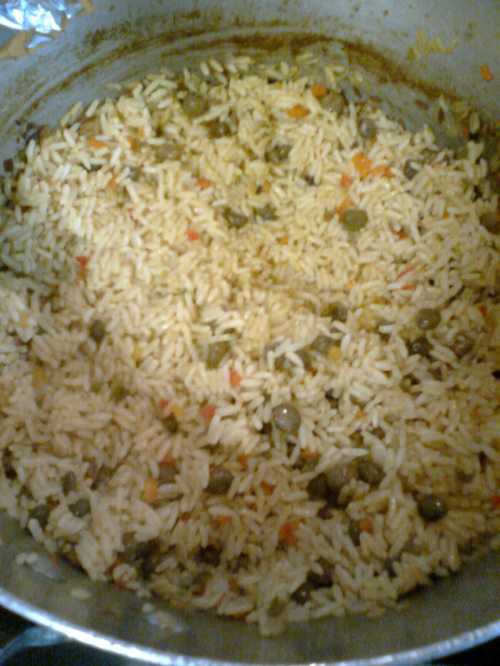I made Jamaican jerk chicken the other day and featured it on our daily changing lunch menu. It read: Jamaican Jerk Chicken – Spicy Grilled Chicken Skewer, Caribbean Coconut Peas n’ Rice, Steamed Vegetables,Grilled Banana. I’ll probably make it again this week so I will take a picture then and post it on the blog…
Some say the star of jerk marinade are the scotch bonnet chilies of the Caribbean – considered some of the hottest chilies in the world. Although the chilies are important to the marinade, you can use any chili available to give it heat – even dried chili flakes or cayenne pepper! The real key ingredient in jerk marinade is the allspice. In my humble opinion, allspice in combination with other dried spices (nutmeg, cinnamon, pepper and clove) and fresh ingredients (scallion, garlic, ginger, coriander, fresh thyme & the all important chilies) define jerk marinade.

The “nutmeg fruit” from the tree at the botanical gardens in Kingston, St. Vincent. The nutmeg is inside the brown seed covered by red mace. The spice is ready to harvest when the fruit splits open.
I love making this marinade from scratch. It is 100% better than the jarred ones loaded with MSG that you can buy in the grocery store and 1000 times better than the powdered jerk seasoning made with who knows what. My recipe for jerk marinade was one I learned from the Jamaicans I worked with at Amanyara in Turks and Caicos. The ingredients are rough estimates and should make around a cup of marinade enough for 1 kilo of pork or chicken. Whole dried spices are better to use but if you don’t have them I’ve included the ground spice equivalents. When using whole spices, use a coffee or spice grinder and grind them into a powder.
Jamaican Jerk Marinade
Ingredients
4 cloves garlic, chopped
2 shallots, chopped
3 stalks spring onion, chopped
a handful of fresh coriander/cilantro (leaves and stems), chopped
a 3 inch piece of ginger, peeled and chopped
2-3 scotch bonnet or habanero chillies, chopped (more chili, more spicy!)
3 tablespoons whole allspice, ground (2 tablespoons ground)
5 pieces whole cloves, ground (1/2 teaspoon ground)
2 fresh nutmeg, ground (about 2 teaspoons ground)
1 cinnamon stick, ground (1 tablespoon ground)
2 dried bay leaves
1 teaspoon fresh thyme leaves taken off the stem, chopped (or 1/2 teaspoon dried)
1 tablespoom sugar
the juice of 2 limes
2 tablespoons soy sauce
1/2 cup vegetable oil
salt and black pepper to taste
Procedure
1. Blend everything together to make a thick paste.
2. Pour over chicken or pork and allow to marinate overnight. A Jamaican Sous Chef I had worked with adds more stems of fresh thyme, rosemary and bay leaves, plus chicken base (or crumbled chicken bouillon cubes) to the marinade and meat.
3. Grill meat over live coals.
Here’s how we made it at Amanyara back in 2008. A bit posh compared to the real deal … but it works for the lunch menu of a luxury, boutique resort in a tropical island. Here we served it with a guava sauce to play on the islands theme, but many times I’ve had it it was served with some gravy I’d rather not know the recipe for.
The thing to use for grilling the jerk chicken or pork is an oil drum grill. Here’s a picture of Milton Harris, Sous Chef at Peter Island Resort in the BVI using one to make jerk pork. Milton covers the pork with “piment” leaves (or the leaves of the allspice tree), before shutting the lid and allowing the pork to steam a little bit in the grill.
I love using jerk marinade on prawns as well. Here’s Terry grilling some at the live action station at Deadman’s Bar and Grill at Peter Island Resort during the Wednesday Caribbean Night back in 2010.
At a Jamaican party I went to once in Provo, the cook doused the chickens on the grill with Red Stripe beer, before shutting the lid. That was probably the best jerk chicken I’ve had – the results were so good! The chicken was served with “festival bread” which is a deep fried quick bread, hot sauce and washed with ice cold Red Stripe beer.
So what to serve with jerk grilled chicken, pork or shrimp? Well there’s that festival bread. Recipe here.
There’s peas and rice or beans and rice. Here’s one made by the lunch cook Laurel over at Peter Island Resort. I asked Laurel how she makes it, and her response was, “I don’t know… I just make it!” But she then went on to share the ingredients: butter, finely chopped onion, finely chopped red and green bell peppers, finely chopped carrot, long grain rice, pigeon peas, chicken broth (made with chicken bouillon base). I like to make mine with all of these (real chicken stock when I have it), plus coconut milk, a few bay leaves, a few sprigs of thyme and with pigeon peas or kidney beans.
And then there’s breadfruit roasted on an open flame. Like this made by my Sous Chef at the Cotton House Mustique, Arris Jacobs, at an excursion to the Tobago Cays in St. Vincent and the Grenadines last year – my favorite islands in the Caribbean!






















